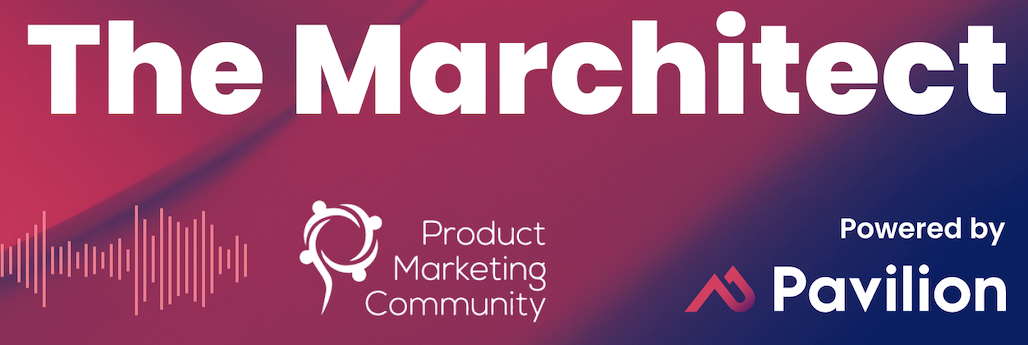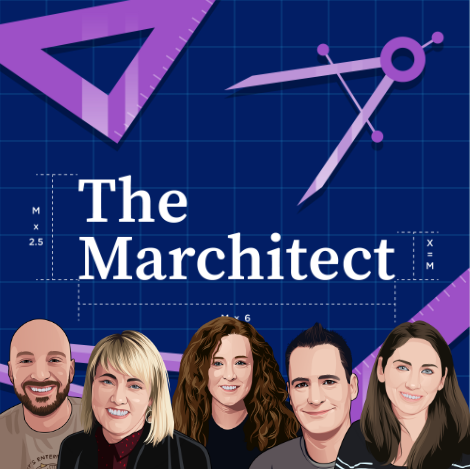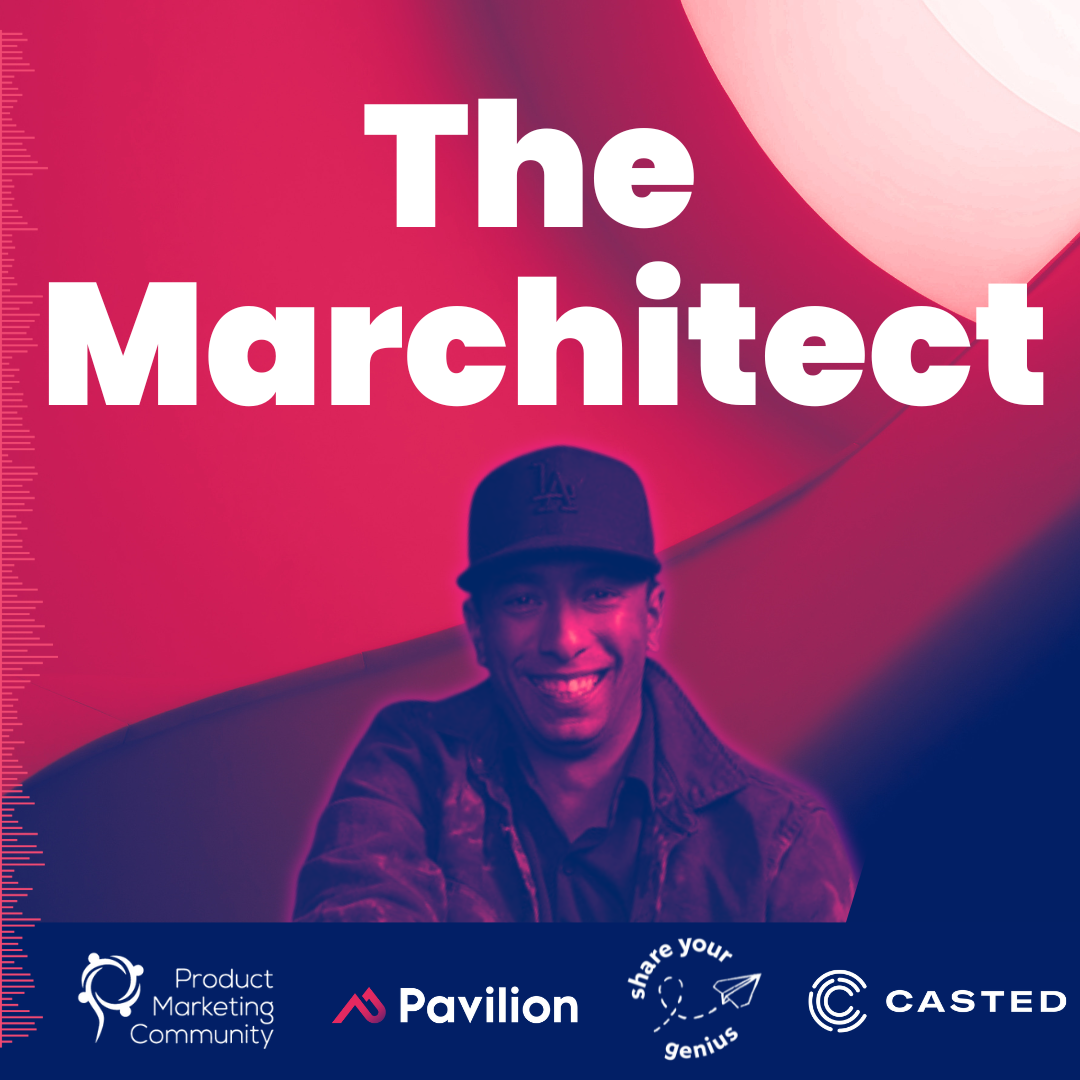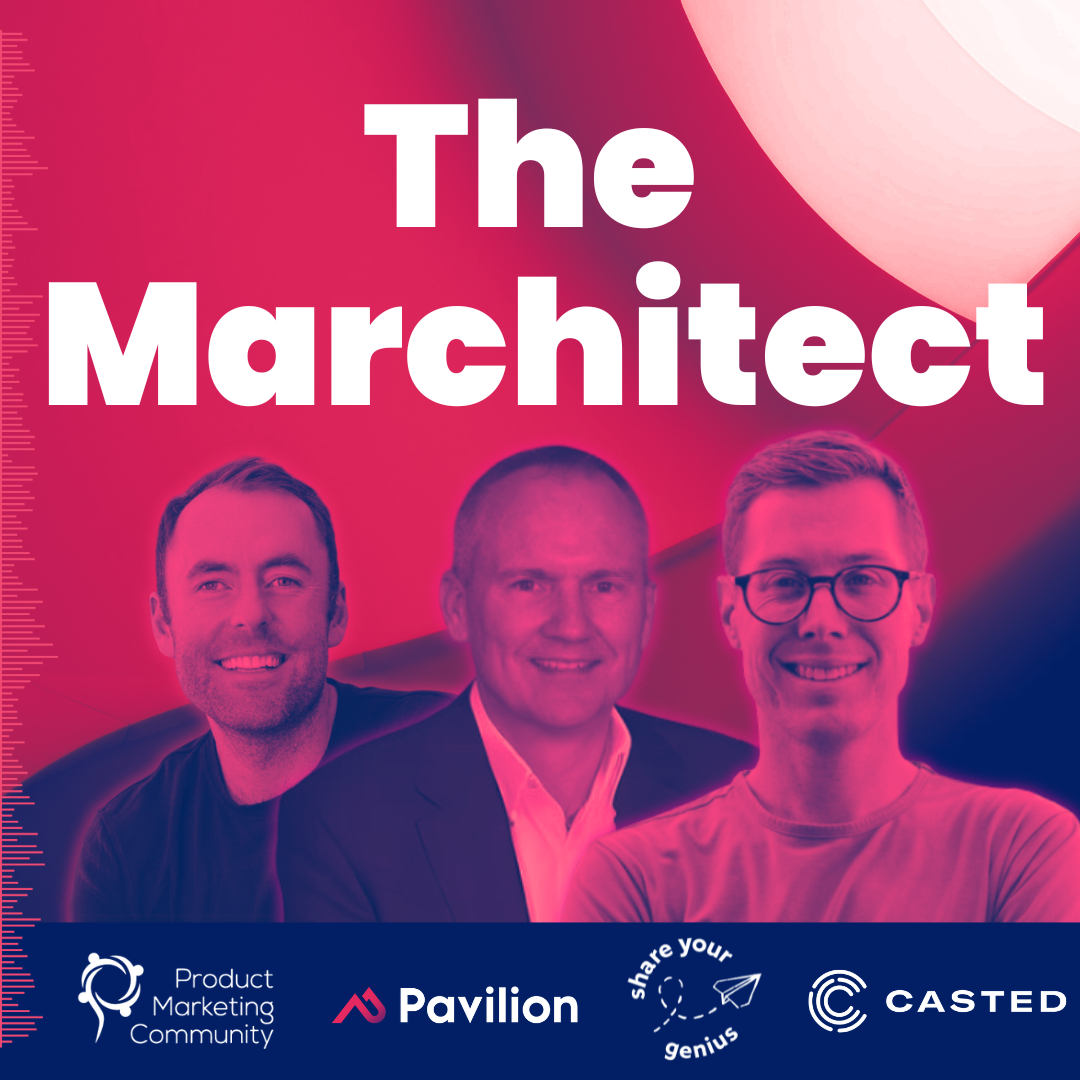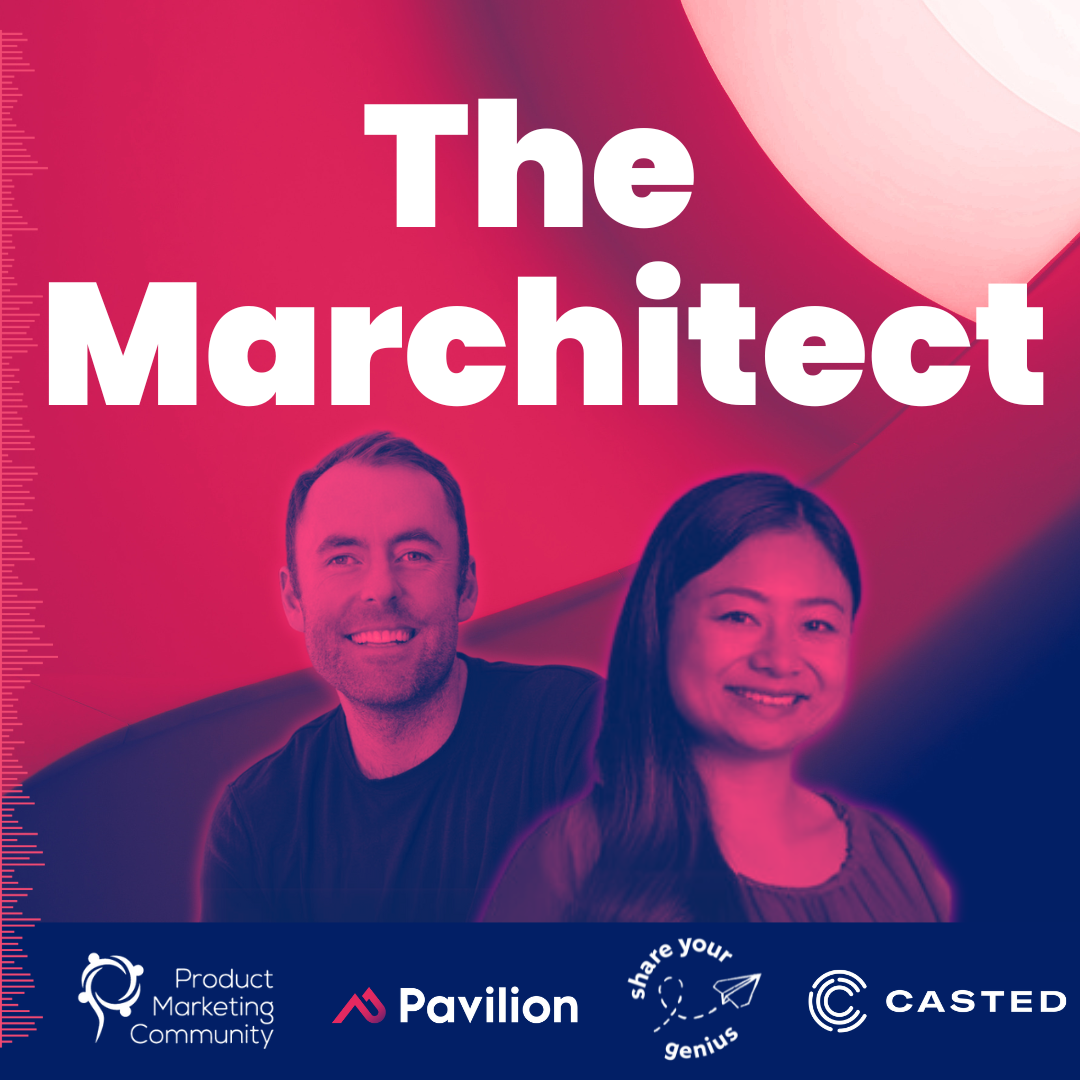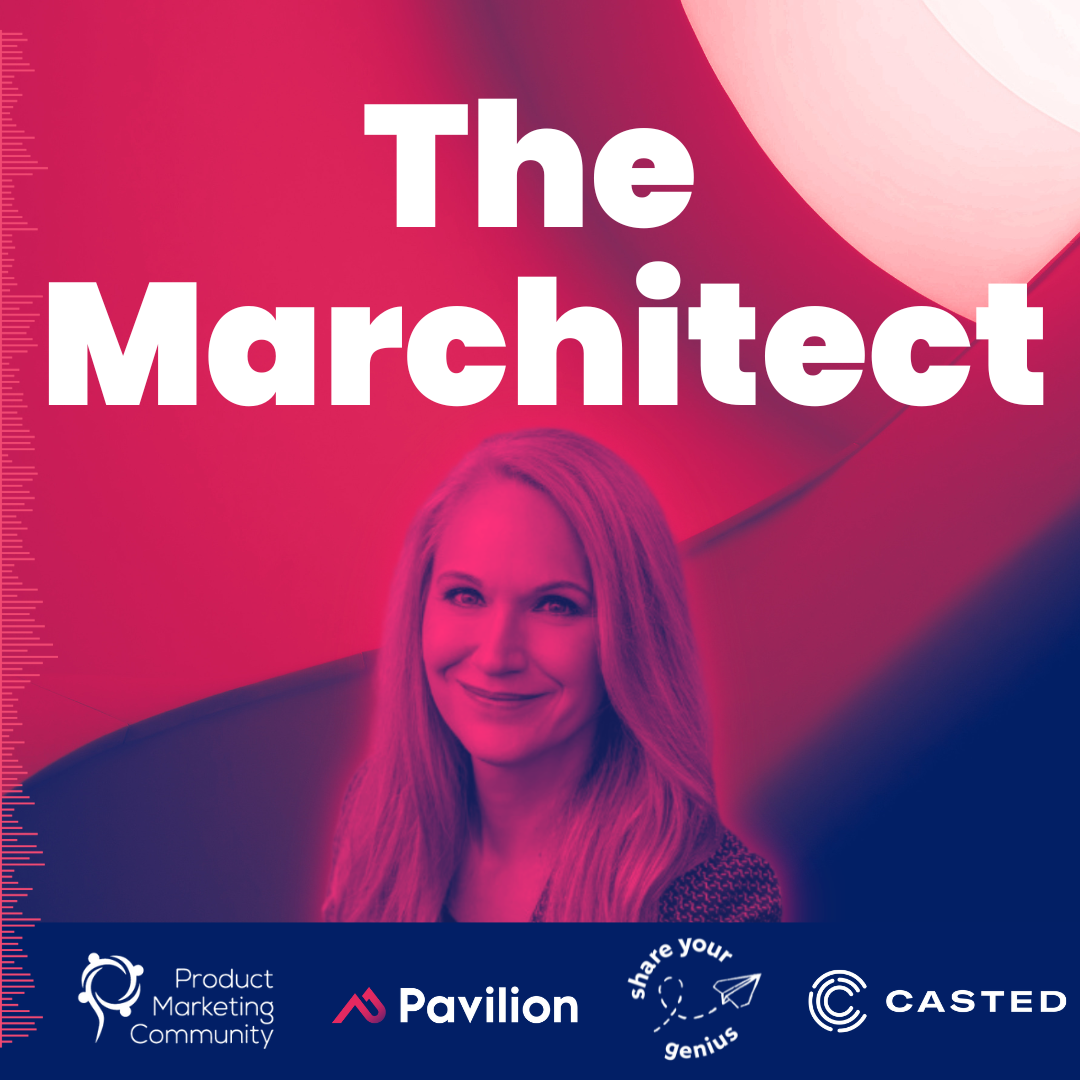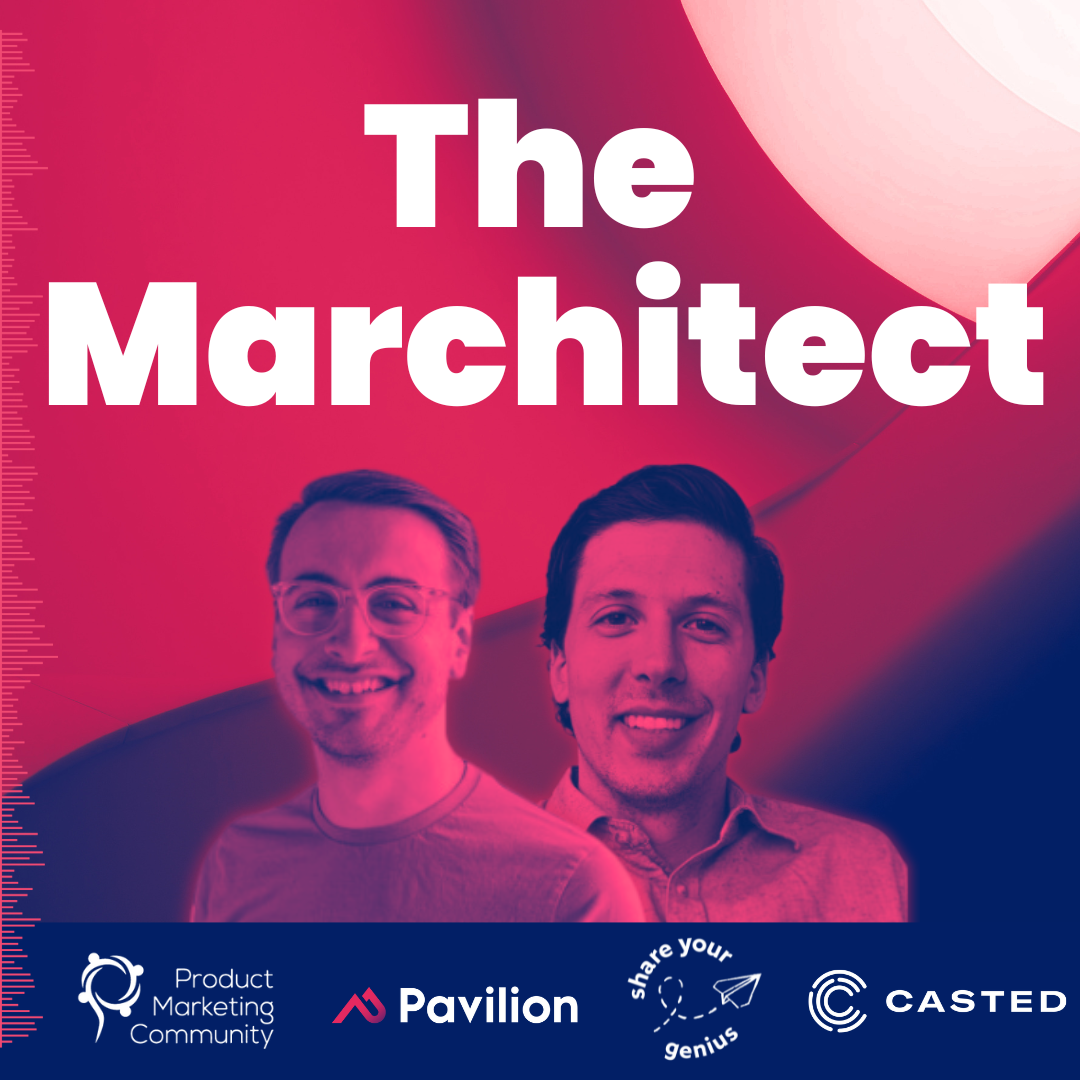Episode 2: A CMO's Perspective: Adapting to New Buying Realities (Gong, Drift, Lessonly, Wanderlust)
- 0.5
- 1
- 1.25
- 1.5
- 1.75
- 2
Lindsay T: The tide has turned. B2B buyers and sellers interactions have changed. Welcome to The Marchitect, a new podcast series for B2B product marketing executives. I'm Lindsay Tjepkema, CEO and co- founder at Casted, the first amplified marketing platform for B2B marketers, and a proud partner of the Product Marketing Community. We are very excited to be bringing you this special series that focuses on amplifying the expert perspectives, insights, and opinions of this brilliant community. Each episode will feature in- depth advice from executives who will tell you how they built impactful teams, optimized go- to- market efforts, and enabled customer- facing teams. The Marchitect is an easily digestible way to learn from your peers as you aspire to be an architect for growth. Welcome and enjoy this episode.
Meg: Super excited to be here and really excited to introduce everyone to our incredible panel of marketing leaders. I'm just thrilled to welcome all of you. What I'd like to do is have everybody introduce themselves, say a bit about their role and what their company does, and then share with us, to kick things off, a little bit about one goal that you're excited about. Let's give folks a little bit of insight into the kinds of things you're looking to do this year. Let me begin with Meghan Keaney Anderson. Meghan, please go ahead.
Meghan K A: Thanks so much, always start off with the Meghans, it's a good bet. Thanks for having me today inaudible. Yes, as Meg said, I am Meghan Keaney Anderson, I've been vice president of marketing at HubSpot, or working at HubSpot now, for the last almost a decade, and I started the company's first product marketing organization there. And actually, a bit of news is that I am going to be moving on from HubSpot. Decided that the decade mark was the right time to go, and so, looking forward to that next chapter and kind of my next step. I think the other thing that's just really interesting right now is, you don't go through the kind of enormous change that the economy and the world and people have gone through in the last year and come out the same on the other side. And so, I'm really fascinated with how the way people engage with companies and products are starting to change and learning from that and instilling that in my strategies.
Meg: Absolutely. Well folks, you heard it here first, some big news getting released on today's discussion. But also, couldn't agree more, right? This past year was an experience like no other and hopefully like none to come, but good things will come out of it too. Next, I'd love to turn things over to Tricia Gellman, CMO at Drift. Tricia, tell us a little bit about your role, your company, and a goal.
Tricia Gellman: Yeah, thanks. So I am the CMO at Drift, I've been here now a year, it's flown by, I can't believe it's been an entire year, and I'm leading everything in marketing. I actually created the product marketing function at the company because it didn't really exist when I got here and that's translating across everything. What is Drift? We are a revenue acceleration platform. We're delivering solutions that bring sales and marketing together to function in a new way that engages the customer earlier in a more responsive way that results in higher customer satisfaction and, ultimately, faster revenue. And that's for both prospects and customers, I'm just kind of referring to everybody together in the concept of customers. But one of my big goals for 2021 is to get back to work and to balance between being a mom and being a CMO, which is a very busy and active, demanding job. So that'll be a big accomplishment. But I think from the work perspective, we started to implement totally new ways to work as a team since I joined the company. And now we have the opportunity to put that to work, to really create a machine where products, sales, marketing, and customer success, everyone are working together lockstep as we continue to grow into the enterprise.
Meg: Thanks Tricia, and congratulations. So exciting to have a new member of the family, but also so exciting to, I think, be in the space that you're in and I love that you're thinking about that in such a holistic way, right? Marketing is part of that full revenue team. Thank you very much for that. Next up, let's hear from Kyle Lacy, CMO at Lessonly. Hello Kyle.
Kyle Lacy: Hello, thanks everybody. Congratulations Tricia. Congratulations as well Meghan. The only reason I use LinkedIn right now is to refresh it to wait to see where Meghan's actually going. So, if you want to tell us at the end, that'd be awesome. So I'm CMO at Lessonly. We are readiness and training software for sales and customer service teams. So that's, if you want to increase MPS, decrease churn, happier employees equal more revenue, knowledge development, all that fits into that. So, my team consists of demand, brand, as well as all of outbound sales. So marketing at Lessonly consists of about 70 or 80% of all net new revenue source for the company, so we're very much a revenue driven org, but we have a brand element that we're pretty proud of. So for me, main focus is learning this new remote world because we're going to finish the year at 200 employees, 150 of them are in Indy, and so we have 50 people that are now remote and we're all learning how to coexist in this environment and to continue to grow at the rate we were doing before.
Meg: Yeah, that's some great stuff. And I especially love that you brought up the combination of brand and demand, right? In today's market, it's so much about both and I think it's wonderful that you take that balanced view. So thank you very much Kyle and appreciate you being here today. And last but not least, speaking of brands, we have Udi from Gong, and I have to say, you guys have some of the most fun marketing I've seen out there recently, some pretty cool spots. Maybe you'll tell us a little bit about that today, but Udi, I'll let you go ahead and do a quick intro and share a goal.
Udi: Thanks Meg. Hi everyone, I'm Udi, I've been the chief marketing officer for the last little over four years. So there were fewer Gongsters in the company when I joined than there are marketers on my team today, so it's been quite the journey in the last four years. I was the first marketer, this is the fifth marketing team that I'm building, we have a lean, mean team and having lots and lots of fun. This year was a pivotal, exciting year. It's the year that we finally stepped into a multi- billion dollar valuation after our recent fundraising. And next year's challenge is going to be making Gong a must- have tool for every sales team. It's a simple- to- describe yet challenging- to- achieve goal. I feel we're surely on our way there, but a lot of the success of this depends on what marketing is going to do next year.
Meg: Yeah, for sure. It's such an exciting space and such explosive growth. It's pretty cool to see and definitely looking forward to seeing how the world domination strategy works out going forward. I like it, think big.
Udi: Yes.
Meg: All right. So let's kick things off with some questions about kind of the broader market that we're in. I know each of us has addressed different kinds of challenges. And I'm going to turn it back to Meghan to lead off on this one. Meghan, what are some of the challenges that you've seen impacting product marketers and what things are they going to have to contend with as we're going into 2021?
Meghan K A: Again, I think it's just been such an interesting year. A lot of people talked about," Oh, is it a V- shaped recovery? Is it a W- shaped recovery? Is it a K- shaped recovery?" And I think, in reality, the economic recovery more resembles a scribble that my toddler would have drawn downstairs. I think that this economic shift has hit industries, regions, companies so differently that, as a product marketer, you have to get a lot more precise about who you're selling to, not just an expertise about the product and its differentiation, but an expertise about your audience and the different layers within that audience and what they're going through right now. So HubSpot, it's a CRM platform that sells to all sorts of different industries. Some of those industries are going through a rough time right now, some of those industries have completely accelerated. And so, you need to do a lot more data and research into what's going on in the industries, the size companies, and even down to the microregions that you're selling into to understand what their aptitude is for being able to engage with you at this moment, whether they could purchase software no problem, or whether it's going to be much more of a longer- term engagement and the goal right now is to hit them with that leadership and with education and not really push products until they're more in a stable state for purchasing. So I think that's it. There's a Etch A Sketch that's been shaken around our understanding of our audiences. And so, diving back into the personas that you're working with is going to be a huge push, I think, this year.
Meg: Yeah, I couldn't agree more. And I love your analogy of the recovery looking like a toddler's drawing. I think all of us are feeling like that. And data's going to be our best friend, has been our best friend, I think, through a lot of this and the insights that we get. Udi, I'd love to hear from you on this one as well. What are some of the things that you think are going to be challenging for product marketers in thinking about the year ahead?
Udi: I'll start by saying that Gong is very fortunate to be in that group of companies that are actually seeing a surge in demand for their products this year. And my heart goes out to many others that their companies are not as fortunate, but this whole new remote work economy is definitely surging the need for Gong, together with tools like Zoom and Slack and the rest of them that we all use now. So, in many cases, we probably have fewer challenges than we would have expected to have this year and beyond. I would agree with what Meghan said. I think it's really about diving into your buyer personas and taking a fresh look at what has changed in their world because the buyer persona analysis that we did even a year ago is just no longer relevant for many of the personas. Gong sells mostly into sales teams and their lives are completely changed, their lives are completely changed. They're using a new stack, they're using new forms of communications to communicate amongst themselves, amongst themselves and their customers, and their tasks at hand have completely changed, so I think that's where product marketing is going to really lean in to understand what are the minute details of how their days have changed and how can Gong serve them better in this new reality.
Meg: For sure. Product marketing has such an opportunity to be a really critical function with those customer insights. And I think the challenge is making sure they get the opportunity to do it and don't get distracted by other things because knowing your customer is the biggest, most important thing we can do, I believe, so thank you. Thinking about that, kind of building on that, Kyle and then Tricia, let's talk about what are some of the trends that you're seeing kind of changing the way product marketers need to behave? What are some of the things happening in the market that will impact product marketing executives in the year ahead?
Kyle Lacy: So I have two, they're pretty quick. I think the first one is, we did this at Lessonly, so it's a little bit different, I think, than everybody else on the call, but we moved product marketing into revenue enablement, so they actually live with it as sales enablement org that has sales engineers, enablement teams. So I think that having a central location where all these people live, I think, is something that is a trend that's going to change over the next year or so. I think the other one is product- led growth. I think the introduction of different go- to- market models is changing the environment of product marketing as a profession. But we all have different definitions of what product marketing means, so for me, it's where does the team live and what is the team doing? And that's the go- to- market models.
Tricia Gellman: I think it sounds like a lot of us here on the panel have a very similar perspective and that is that product marketing isn't just about working with product. So Kyle saying that the product marketing org is moving into sales. I started by saying my goal for next year is to really have marketing and sales and customer success working together with product to kind of have this unified revenue, go- to- market team. And I think, this is I think the biggest trend. It's great to have this new organization that Rowan's put together, but it's funny because we are referencing everything as being called" the marchitect," and I can tell you that four months ago at my company, people didn't understand what a marchitecture even was. That's such a product marketing thing that we take for granted, but more than half the company didn't even know what a marchitecture was when I started to present the fact that we needed one. And so, I think, one of the biggest trends is that product marketing is increasingly in the spotlight. When I started my career, product marketing was something no one understood. And then now, I think it's becoming a part of the spotlight, which means leaders have to be more connected to the organization, they need to be more connected across the teams, and they need to really help to be a part of that revenue machine. And that means the product marketers need to focus, like Udi was saying and others, on audiences. I think that's always been a strength of product marketing to do the persona research. But then, now, to figure out how that then translates into your demand function, your growth function, working with the product team, making sure everyone's aligned. And then finally, I think for marketing organizations across the board, the biggest aha from 2021 is we're not just about generating new revenue, we're about generating revenue from our existing customers and really responsible for customer success and helping with that as well. And so, that is a pivot, I think, for product marketers who, especially if they lived in the product organization in the past, really need to think not just about what is the product we're building, how do we message that, but how do we work with enablement for sales, for customer success, and ensure that we're looking across the entire life cycle.
Meg: Yeah, thanks Tricia. And I love that you guys are looking at that as revenue enablement, right? Enabling that entire go- to- market team, I think that's a really, really important shift. Now, Meghan, I'd love to turn it back to you. Can you share a little bit about where product marketing sits in your organization? We've heard from Tricia a couple of different changes and adjustments that she's made and a little bit from Kyle as well, I'd love to hear more from you. And are there any changes you're looking to make, or you think are going to get made, in this coming year? Or even thinking about your next role? Some things that you might like to do differently about where product marketing reports.
Meghan K A: Yeah, it's so funny because structure is this time- old debate around product marketing. Does it sit in product? Does it sit in the marketing team? Does it sit with the sales team? Is it sales enablement? And the reason it's such a debate that will never... I'll tell you an answer today, it's going to be inaccurate not a year from today. And the reason I think that where product marketing sits is so debated is that where it sits really aligns with what the strategy for product marketing of that moment is. So if you are a product- driven, product- led growth company, it might make most sense for your product marketing team to be really embedded with the product team because they're going to need to make changes based on product marketing positioning and observations and persona work to the actual onboarding flow of the product. If you are going through a major change in the world, as we are today, where knowing your audience and understanding not just your buyer persona but your customer persona is really important, you're going to want to sit more closely to the go- to- market teams. And so we've actually seen product marketing move around quite a bit over the course of my tenure. We've always, at HubSpot, always had product marketing in marketing, but we did tricks like we had the product marketing team, back when we all were in offices, had the product marketing team embedded with the product team so that they sat right next to the engineers and the PMs who actually built the software, even though they were direct reporting up into a CMO. So we tried to kind of split the difference a little bit like that over our time, but there's trade- offs, right? You move too far away from the product team and you lose that trust and insight with the organization that you're supposed to represent. You move too far away from the go- to- market teams and you lose track of the customer and the buyer and you make up positioning that maybe doesn't actually really resonate on calls. By the way, that's where services like Gong comes in, we spend a lot of time listening to Gong calls on product marketing so that we can keep that tie to the sales team and to what messaging was working while we were embedded with the product team. So, all of this is to say, it's a boondoggle. I think that you just need to know why you're making the choice about where product marketing sits and know the trade- offs that are going to come with that, because structure does influence strategy.
Kyle Lacy: If I'm thinking product marketing, I will always go ask Meghan, frankly, but for us, it was moving product marketing under an unbiased team. So when I say revenue enablement, revenue enablement doesn't necessarily report into sales, they are their own, they live apart from it, and they are kind of the structure that keeps everybody together so that you don't have ownership issues between me as a CMO or our CRO or the product managers. You have somebody that's living in the middle and those enablement people are in Gong every day, they're in Chorus every day, they're in all of these tools that we use to make sure we're keeping track of that messaging. So that's why I like the enablement team. Now, we're a much different... We're 200 people, much different than HubSpot, right? So, for me, that's why I like it there because it's unbiased and it allows us to work off of each other and have dotted lines where communication continues in a way that's meaningful, at least at our scale right now. But again, nobody has any idea where it should live, and it's a product marketing thing. I couldn't tell you. I cannot tell you where it should live, but that's how it's working at Lessonly.
Meghan K A: I do think Kyle, if I can jump back in, that idea of... I'm assuming that your ops people are in that central revenue enablement team as well, right?
Kyle Lacy: No, they're in finance and ops.
Meghan K A: Oh, interesting, okay. Because one of the things that I do think is interesting is having a unbiased team that does reporting and that helps surface the data that becomes that source of truth for all teams. I've seen a lot of people start to centralize ops as well, which is not product marketing, but certainly impacts their work.
Meg: Yeah, I think what I appreciate about the way your role, all of you really, are thinking about where product marketing needs to sit is that you go back to, what are we trying to accomplish as a business and what is the right place for those skills and that knowledge to live now based on what we need to do, right? So many times, in my past life as an analyst, people would ask," What's the best way to do this?" And they always hated it when the answer was," It depends." But it actually does, it depends on what you're trying to do and who you got and where they need to be to do the work. So I appreciate that you guys are taking a flexible view of that and not just saying," It has to be this one way," because it really doesn't, right? It depends. So kind of building upon that, Tricia, I'd love to go back to you for a minute and maybe you can share with us, sort of looking back over the past year, what were some of the smartest things you saw your product marketers do given the dynamic market that we were in? What were some really cool things that happened?
Tricia Gellman: Yeah, I think, just sort of merging the last question and this one together, I think, we have been looking at product marketing as a whole new function within Drift, and our CEO, David Cancel is, I would say, a master in messaging and marketing. And so, that's really what carried the company with the messaging and really sort of the product marketing function in a way for the first, even four years. But as we've matured, we've started to see that we really needed a dedicated function that could understand the personas, that could understand, what are we trying to do? Where are we trying to go? And could be sort of a go- to source for product and for demand gen and really help to talk about a lot of these different functions that we've been talking about today across the group. And so, in hiring the product marketing function, because it didn't exist a year ago, we had two product marketers technically that were in product, but they were so embedded in product that all they did was sort of take an over the fence approach of," Hey, we've built this thing, so now can you give it a name and/ or give it a message?" And I think this is one of the challenges of where product marketing lives and what it is people need to do. And I think we're evolving out of that world. In the past 10 years, I haven't hired a product marketer who only does messaging of product. It's really been a key function to understand the customer, be at the center of who you're going after, understand the audience, work with product on that, and then also work with the rest of go- to- market. And so, that's key. But as we see this trend of product marketers being more important in an organization, we also see that the organization does not understand what product marketers do. And so, I think the smartest thing that my team did this year is they banded together and they decided they were going to create a standard definition of product marketing in Drift. And they created a roadshow presentation and they looked at, what do we do? What do we want to do? What do we do today, because we're three to four people, versus what are we going to do in a year, because we know we'll probably add a few people? And really laid that out clearly because product marketing is good at telling stories. And so, they put together this presentation, and I helped them and I coached them, and we really articulated clearly, what do we do? Why do we do it? What are the goals we have? What is the outcome we expect? And also, clearly, what does product marketing do versus product? What does product marketing do versus demand? And this is going to be different in every single company, but having that central document and then doing an actual roadshow across the company to say," Hey, look, this is what we do. And if you look back on the past six months of us doing it, you can see we created the launch of this product. And it wasn't just about the messaging, it was about engaging an entire new audience of people and getting beta testers and all the things that went into reaching that audience." And so, people can really grok and understand, what are we doing? What's the outcome? And then reference back to it so that, moving forward, everything can be a little smoother and smarter.
Meg: That is super cool. And I would love, maybe we can get some of the folks on your team to tell a little more about that in the Product Marketing Community because I think that is an amazing way to help the organization really understand what this critical function does. Because I agree with you, there's a lot of sort of misunderstanding about it. I love how you approached that, that is very cool.
Tricia Gellman: Maybe we can get Xabier, who's our new VP of product marketing, to participate in the community about that because what I did was I built the team from the bottom up, right? So hiring the product marketers, and then hiring the VP of product marketing, which is one of the most difficult hires ever. And Udi just went through it too so he knows. But it ended up being a great way for that person to start because he helped to lead that roadshow and it helped to establish, who is he? Who's the team and everything underneath it? So I think Xabier could share a lot with you guys.
Meg: Oh, thank you, that would be amazing. And speaking of Udi, I'd love to ask you to take kind of the flip side of this question, which is, looking forward, what are some smart things you'd like to see your product marketing team do in the year ahead?
Udi: Yeah, so, I'll skip over the obvious of there's always work to tighten up messaging and more collateral for sales enablement, that's sort of the run- of- the- mill stuff, even though a lot of it is actually strategic. I think one interesting product marketing area that we are going into, or two actually, one of them is pricing and packaging. For most of us, this sounds kind of boring and mundane, but I've got to tell you, over the last month or so, I've been interviewing pricing and packaging experts, these are some of the most passionate people you've ever met that geek out about pricing and packaging in a way that you cannot help but get excited as well when you hear them talking about pricing and packaging and talking to people who've been doing this at either some of the world's best management consulting firms and some of the best SaaS companies. And we just hired someone who's starting in January to lead our pricing and packaging and I'm super excited about seeing what that can do. Imagine in the very modest case, if that person can add 5 to 10% revenue on the same product with the same customers, that is huge for a company like us that's doing a nine- figure revenue number next year. That's a lot of money, so I'm super excited to see how pricing and packaging affects our revenue and our go- to- market and I'm just proud to have that as part of my team within a month. The second thing that Gong is going through next year is, and you and a couple of you mentioned, Gong's fun marketing. So we're getting into this tension point where our marketing is going to remain fun, it is going to tighten up a little bit and get a little bit more enterprise- worthy, as someone told me this week. We're going to do a few things around product marketing and creative to reduce any sort of friction that we might be introducing into the enterprise buying process of Gong. Because, like many companies, we started by selling to small and medium- sized businesses and our first few hundred customers were from that sector. Today, we're lucky to have some of the world's biggest enterprises. And I, unfortunately, can't name a lot of them due to their privacy concerns, but many of the world's largest enterprises are Gong customers and our upmarket sales team is having some concerns that we might be a little too cool for some of them. So when one of these Fortune 500 companies checks out our website or our social media, there are things that might deter them and make them second guess, is this for us? And so we're going to have to find a way of marrying our love of being different and provocative and sometimes controversial, and I promise we won't become boring, not on my watch, but in a way that will also be conducive to more enterprise buying.
Meg: All about understanding what your customer can and can't take on, but pushing boundaries isn't a bad thing either, right? Like you said, boring is really the worst thing you can be. So, an interesting dilemma there, but I appreciate your perspective on that. Let's go now to what I like to call lightning round, we're going to ask a question of everybody on the panel. And that question is, in a word or two, what is the biggest skill you think product marketers are missing today and what action can they take to acquire it, kind of building their own development plan or how you're planning to help them in the year ahead? And I think maybe we'll kick things off this time the same way we kicked off our first one. Let's go back to Meghan.
Meghan K A: Okay, so the one word thing is killing me, but I always point to agility or adaptability. I think that because product marketers have to be good at positioning and differentiation and then also really good at distribution strategy and really good at research and analytics and the world is changing really, really fast and your product line is changing all the time, you just have to be incredibly adaptable and be able to know a little about a lot across the entire strategy. You're sort of a mini CMO for your product line and that can be hard to find. It's why hiring a VP of product marketing is so hard, as people were looking to before. It's why product marketers are really unique and special and valuable because that ability to be really good at, say, positioning but pretty darn good at a bunch of other aspects of marketing and even sales and service, that's pretty valuable.
Meg: Absolutely. Especially after the year we just had. Let's now go back to Tricia. Tricia, what's the skill you want to see people acquire and any suggestions for how they can get it?
Tricia Gellman: Yeah, I mean, I think the number one thing, I think, that product marketing leaders need to look at is really, how are they doing with empathy and listening? Because I think really what we need is product marketers to realize that if you are in a leadership role, you really need, especially in these tough times, to lead. And that means having empathy, it means listening, it means not just being focused on the product but also on your customers. One of the other panelists mentioned really going back and revisiting the personas because so much has changed in the past year. That is having empathy and listening with your customer. But really, we're at the point now where no one thought we would be that, almost for a year, we've been working remotely. We probably have people on our teams that we've never even met in person. We talked about how we have people that are in remote offices, which HubSpot didn't necessarily have before or Drift didn't have before, and you need to listen to your employees. At the end of the day, we need to drive for growth because it is a tough market for making your revenue numbers, but your employees are really maxed out. And I think we've talked a lot about how product marketers are helping with product, product marketers are helping with the go- to- market teams, with enablement. It is a lot. It is a full circle sort of mini CMO role, as Meghan just said, and product marketers need to lead. They need to have the relationships with the leaders to understand the clear priorities. They need to have the ability to not be the person getting their hands dirty, doing the work and delegating it, but also empowering their teams and then making those tough trade- offs so that everyone's not burnt out and working seven days a week, 24/ 7. I mean, this is really a key thing about being a leader in today's time.
Meg: I love it. Agility, empathy, listening, empowerment. These are such great words. And I think it's a great time, in a weird way, to be a leader because I think we've gotten permission to help our teams get through a hard time, but it's also changed the way that I think people look at leadership to give an opening for some of these more human connections. So I love where you're going with that. Next up, Kyle, how about you? Skills? Ways to acquire them? What do you recommend?
Kyle Lacy: Yeah, I go high level with my first one, which would be just continue to evolve your ability to align with teammates and have dotted lines as you grow. I think that's a skill that all product marketers need to have. I think getting really granular. I would love product marketing to develop more of a pricing mentality, like Udi mentioned. I think a lot of product marketers tend to not have that pricing, at least the people that I've run across. The best pricing person I've ever worked with is Kyle Poyar from OpenView. And if product marketers could spend more time understanding that, I think pricing is going to be a huge competitive advantage if you have that as a skill set moving into next year and the future, just because of all the new go- to- market models that we have coming out now.
Meg: We have an amazing interview with Kyle from OpenView that'll be up on the community soon.
Kyle Lacy: There you go.
Meg: He's amazing, I agree. But sounds like we've also got another topic. So, Tricia, we can have your team talk about the charter for product marketing and how to communicate it, and it sounds like between Udi and Kyle and other Kyle, we may have a great conversation on pricing and packaging too. So thanks for the good ideas today.
Kyle Lacy: Oh, this Kyle cannot be involved in that conversation because Kyle Poyar is the best I've ever worked with, so you're good with him.
Meg: You can get that interview out the way.
Udi: Same here, you're going to have to wait for my new pricing guy to hear something intelligent about pricing. I wouldn't assume that I could be that person.
Meg: We'll keep tabs on that then. And actually, last but not least, Udi. What would you like to share in terms of a skill and a way to acquire it?
Udi: Better demonstrating business value or impact. That's, I think, a huge thing that product marketers, at least many that I've interviewed, completely goes over their head. They jump into the tactical of the amazing enablement materials that they create and they talk about empathy and listening to customers. But where is the business impact that you make? What product line exceeded targets thanks to your product marketing work? What product launched to the market in half the time thanks to your product marketing work? What pricing work have you done that increased the average deal size by 25%? You have to be able to show these things because we all have to. Some of us have been marketers for many years, not you, you're all youngsters, but people like me have been marketers for many, many years. 10, 15 years ago, we could have put on a nice website at a nice event and everybody applauded. But today, we have to show business value. We have to show how much of the pipeline we're contributing. We have to show how much upsells we're contributing. We have to show all these financial metrics. Product marketers cannot get away without that. They have to be able to demonstrate business value.
Meg: Yeah, for sure. Well, and thanks for anticipating our topic for the close of the panel today, which is around, how should product marketing be measured? Udi, you just shared some, I think, excellent examples of how product marketers can make their work more connected to the important business outcomes. Let's go back to our other panelists and hear a little bit more from you on that. Maybe we'll start with Kyle on this one. Kyle, what are some ways you think product marketing should be measured or you are measuring product marketing today? Any advice you'd like to give?
Kyle Lacy: Revenue. From a marketing perspective, I think marketing should always start at revenue. I think this idea that attributed influence and pipe, I mean, pipe's important depending on the segment you're in, but this idea that we influence stuff is just a bunch of BS, in my opinion. Marketing should be influencing 100% of revenue all the time if you're doing it correctly, especially when it comes to expansion revenue, which we've talked about a little bit today, because at a certain scale, expansion revenue is actually more valuable than net new for companies, right? So for me, it is revenue. And I think that from an enablement perspective, it really depends on the tech stack that you have. At Lessonly, because we sell readiness and training software, our enablement team, we focus on, all right, the productivity of the sales reps after they go through an enablement. So if they spend a ton of time trying to understand a new ICP, as an example, what is the impact in their close rate by rep depending on how well they did in the training? So you can get really granular, but I think overall, it's like, what impact did you have on the revenue generation based off of what you did as a product marketer? Which we've discussed can be a very broad range of things. If it's pricing, Udi's already talked about it, if it's ICP stuff, it's a certain segment increasing in closed one revenue.
Meg: For sure inaudible, if I do this, then this should be the impact we see. I like that connection very much and very practical too, right? And cool that Lessonly can help kind of give some of that visibility also. That's, I think, an important thing to keep in mind. Next, let's have Meghan, I'll have you weigh in and then I'll close with Tricia. Meghan, what are some ways you think product marketing should be measured? And what are some of the best things you've seen in terms of product marketing measurement?
Meghan K A: Kyle hit the nail on the head. I think that you got to tie your work to revenue. And I think that, so at HubSpot we have the product GMs, the product marketers, and the go- to- market leads all share the same kind of revenue goal for a given product line, and they have their unique ways of moving that forward. So in addition to that, so you've got the macro revenue goal, then you can kind of look at like, okay, what are the drags on revenue today? So places where we're seeing churn or we're seeing not enough upgrades. And then, what are the opportunities with revenues? So that's like a new product line. And you can create these micro goals around those particular points. So, were you able to increase the number of cross- sells and upsells with a particular campaign that you ran as a product marketer? Or how successful was the new product line launch that you introduced that year? And that gets you a little bit more into the more concrete, tangible metrics that people can kind of chart their days and their strategies against. But even those can't be disconnected to... They all have to roll up to that larger revenue goal.
Meg: Yeah, for sure. And Tricia, how about you? What are some of the most important measures you think product marketing should put in place?
Tricia Gellman: Yeah, I mean, I think one of the key topics here is just actually having this measurement that ties back to the business because I think for the product marketing team to feel like they're making a difference versus just working really hard, being able to measure is important. And it requires that you put in place, potentially, some other tools in your toolbox so that you can measure really the impact. But I think, in the end of the day, measuring through the entire funnel, so from that new audience acquisition through to the purchase through to the customer satisfaction on the backside, I think watching what's going on through that and then looking at where you prioritize the time and effort for your product marketers is very important. And then you can turn around and you can say," Hey, by having this new message, we acquired more people. By introducing these new assets and offers with the content team, we were able to move people through the funnel faster by having this new message." I mean, we repositioned the entire company from conversational marketing to a revenue acceleration platform. And by doing that, we're able to talk to people at an entirely new level. So we're talking to more executives who are willing to engage with us now, and we're able to look at what our deal cycle times are. So, I think we've talked about several of these things and I agree with everybody. It's really important to just identify what are the key components to your revenue success today and how can you really parcel out the work for your product marketers to align to those goals?
Meg: Yeah, it really comes back to sort of how we talked about org design as well, right? What does your business need to accomplish? What are the ways product marketing can and should contribute to it? And how can you judge whether or not that's been successful? I think you guys have all given people some really, really great ideas for how to do that. Thank you, it's super hard. And with that, I think we will bring our amazing panel to a close. I thank you all so much. All of you are doing so much amazing, exciting, and innovative work. It's an honor to have you here. Thank you so much for supporting the Product Marketing Community and for taking time with us today.
Lindsay T: That's the show. Thanks for joining us. Make sure to visit productmarketingcommunity. co to subscribe and to get more information on how you too can become a marchitect at your organization.
DESCRIPTION
What used to work had to be shifted, adjusted, and changed to fit the new landscape. What could possibly be next? Throw out your pre-covid blueprint. The Product Marketing Community brought together an all-star cast of inspiring thought leaders to take us in the right direction for 2021 and beyond. During this podcast, our Editor-in-Chief, Megan Heuer, talked to the CMOs of Gong, Drift, and Lessonly, and the Wanderlust Group about what it means to throw out what we once knew and adapt to b2b decision maker's new expectations, spending, and buying behaviors
Read the full summary in our blog.
Interested in contributing? Contact our founder, rowan noronha.
